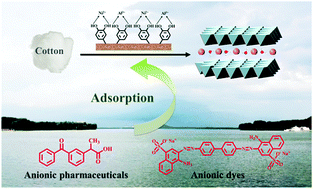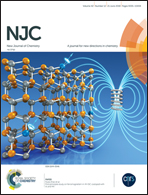Cotton fiber-supported layered double hydroxides for the highly efficient adsorption of anionic organic pollutants in water†
Abstract
The immobilization of crystals on proper substrates is important and challenging in functional material fields. Cotton fiber is a natural material, which possesses several advantages such as low cost, biodegradability, large specific surface area and hygroscopic properties beneficial for mass transfer. In this work, layered double hydroxide (LDH) crystals are in situ immobilized onto cotton fiber via a facile polydopamine functionalization procedure. Compared with the free-standing LDHs, the LDHs/cotton fiber composite exhibits a superior adsorption performance with a higher adsorption capacity and fast adsorption kinetics for anionic organic pollutants in water. The maximum adsorption capacities of the composite are 625 and 714 mg g−1 for ketoprofen and Congo red, respectively. Moreover, due to the superb shape adjustability of the cotton material, the resulting composite can be applied in multiple devices and used in different conditions. In addition, the spent composite can be easily recycled by simply washing it with NaOH aqueous solution. Therefore, the cotton fiber-supported LDH crystal composite is a promising adsorbent for the removal of anionic organic pollutants from water.



 Please wait while we load your content...
Please wait while we load your content...